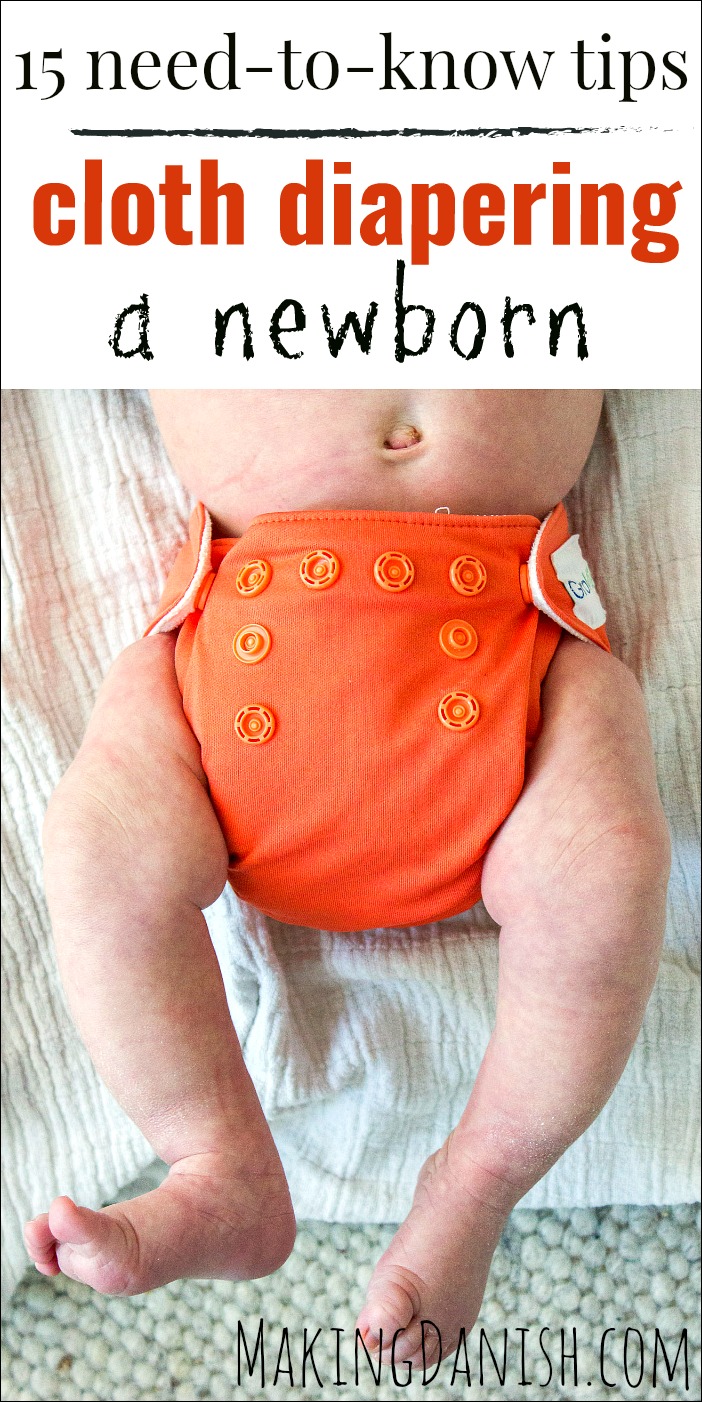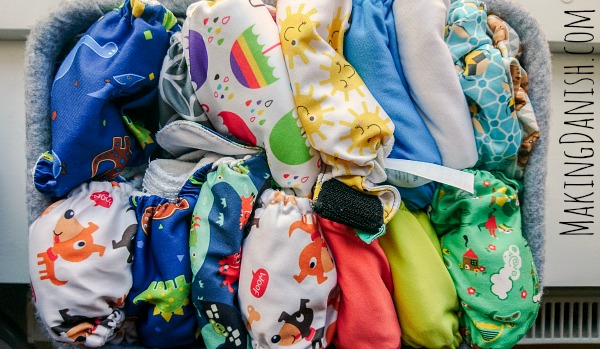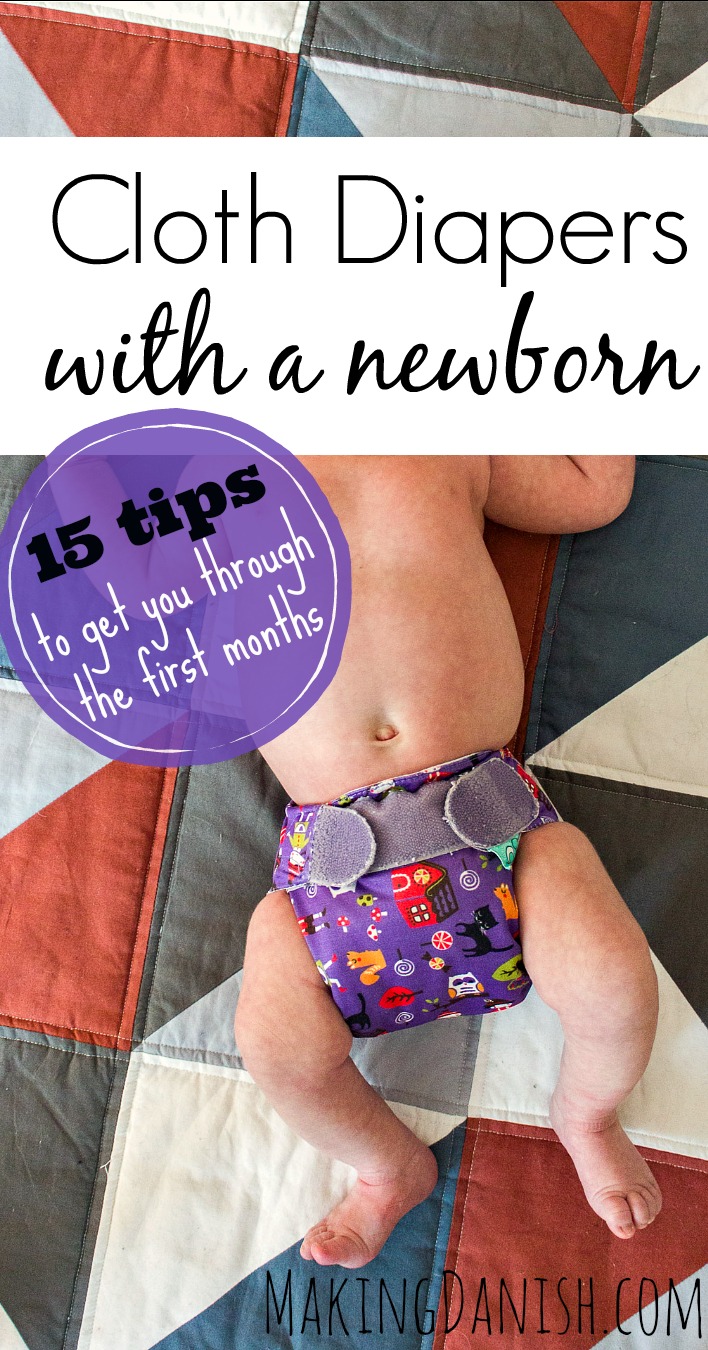15 tips for cloth diapering a newborn
15 tips about cloth diapering that any parent who’s considering cloth nappies with their newborn should read – I wished I known them all from the start!

Cloth diapering can be a bit overwhelming at first sight – especially with a newborn. There are so many options and new terms to learn and then on top of it all, you might be dealing with people questioning your decision to use cloth instead of disposables. I dealt with a handful of horrors stories from older generations about their time cleaning old fashioned flat cloth diapers by hand in buckets that made the whole home stink. And to be honest, I’m glad I didn’t have to deal with that! But luckily cloth diapering have evolved and so have the ways of cleaning them (hurrah for washing machines!). And there’s actually no easier time to clean cloth diapers than those first few months where you’re baby is not eating solids (see tip no. 8).
15 tips for cloth diapering a newborn
Cloth diapering a newborn can be a bit confusing and hard to get your head around, so I’ve rounded up the 15 tips I’d wished I’d known before I started cloth diapering my newborn.
1. One-size isn’t really one-size, so you will most likely need newborn diapers.
Most onesize diapers won’t fit until your little one is at least 4,5 kilo (about 10 pounds). Anton couldn’t fit a one size when he was born (and he was also quite a big baby) and from what I can understand, most newborns will be too tiny to fit a one-size diaper from the get-go. Their legs are simple not chubby enough and they aren’t really that long yet. Instead of one-size diapers we therefore decided to go with a mix of newborn all-in-ones, a few fitted diapers with a wool covers for the night, a bunch of extra inserts and a few prefolds. That combination worked really well for us.
2. The black gooish poo known as meconium is not something to be afraid of.
Just use a fleece liner if you don’t want it in the diaper, a really old cloth that needs to be tossed anyway or simply deal with it. The meconium can be washed out and it doesn’t leave markable stains after a few washes. That being said we went with the old (super soft) cloth that needing throwing away, since we unexpectedly ended up at the hospital for a few days despite of us having planned a home birth and we just didn’t have the energy or mental capacity to wash cloth diapers with meconium in a sink. But seriously, it should be easy to wash out – despite it’s rumour.
3. Keep it simple – especially if you’re new to cloth diapering.
My suggestion would be to either go for the all-in-ones (if you have to choose between velcro and snaps, I would go for a the velcro. When your little one is still a newborn I find the space between the snaps to be too wide making it hard to just adjust them a little – plus it’s easier if you’re already use to disposables) or the fitted with a cover. They might be bulkier, but they are almost leakproof even if the fitted diapers don’t fit so well. The aio’s are super easy – especially my absolute favourite newborn diapers from TotsBots – but you might be unlucky that it won’t fit your little one so well. That’s why we bought a few different brands just to be safe.
4. Buy used or either borrow or rent a new born stash.
Newborn diapers can be quite expensive considering the amount of time you use them. Especially if you use aio like we did. But if you buy used diapers they’ll most likely be in really good conditions since they’re only used for a very short period of time. And as an added bonus, unlike new diapers you’ll probably be able to sell the again without a noticable loss. All but 2 of Antons newborn diapers were second-hand – and you almost couldn’t see it.
5. Buy extra inserts for added absorbency.
Unless of course you like to change diapers every hour. It won’t be long before your little one starts peeing a whole lot more than many new born diapers can handle. They extra inserts won’t be a waste as you’ll most likely be able to use them as your child grows. Anton is over 6 months old and I’m so happy we bought a lot of inserts as I use them daily! And during those 1,5 months he was in newborn diapers we use to boost every diaper with a small insert from Little Lamb from he was around 1,5 weeks old. It made a world of a difference.
6. Prep your newborn diapers as well as inserts before your baby arrives.
You prep your diapers by washing them. For best absorbency I would say at least 3-5 times where you let them completely dry in between washes. Or you could do what we did and just wash the diapers once or twice ind advance and accept that the absorbency will become better after a few more washes and that you might need a few extra diaper changes in the beginning to be on the safe side.
7. When cleaning poopy diapers just pop them right into the washer without rinsing.
Poop from an exclusively breastfed baby doesn’t need to be washed off before going in the diaper pail. It’s completely water soluble. It’s soooo wonderful and seriously makes cloth diapering in the first 6 months a breeze.
8. Use cloth wipes.
You know you’re going to wash the diapers anyway, so why not make it easy and wash the little bum with a cloth wipe that can be tossed in the washing machine afterwards? I prefer wipes that have a side with a terry fabric like these baby wipes from Cloth-eez or the reusable wipes from GroVia.In my opinion terry fabric absorbs water better and in general makes it easier to clean that poo from your little one’s bottom. You could also cut up an old towel or T-shirt if you are on a budget.

9. You might need both a daytime and nighttime solution even from the beginning.
I didn’t think we would need a special solutions for night time use before Anton was much older and in one-size diapers, but apparantly I was wrong. Our little guy would sleep for long stretches during the night for the first few months (and then things started changing…) and would be really cranky if I tried to change his diaper when he finally woke up to feed. So instead we (or well, I) decided to go with a wool cover solutions over a fitted diaper with extra inserts. I love wool covers. They just work – and who doesn’t love waking up without everything being soaked in wee? I know I do.
If you’re vegan, your child is allergic to wool or you just don’t want to use wool covers consider a pul cover instead. I did that a few times as well, but prefered the wool solution. We ended up using these wool covers with short legs and a high rise, so the diaper would always be covered really well. If you do choose a wool cover, remember to buy lanolin and to lanolize the covers before use.
10. There will be bulk, but it’s okay.
And a lot of it. It might look a bit crazy on this tiny little humant that have just entered your lives, but before you toss the diapers in the bin because “it can’t possible be good for them with all of that bulk compared to a disposable diaper ” just remind yourself that disposables are quite a new invention. The older generations haven’t been swaddle in superabsorbent plastic Pambers and most of them learned to walk perfectly fine. And some suggest that the extra width between the legs is actually a healthy positioning of the hips.
11. You can live without the snap down button for the umbilical cord, but it’s a nice feature.
It’s quite neat, but on one diaper I felt it made it leak and on another I just felt it was unnescessary. Otherwise the cord was either tucked under or way above and we had no problems with it.
12. If you’re on a budget go for prefolds or flats with a few newborn covers.
Both the flats and the prefolds can be used for most of the cloth diapering period, so it’s worth the investment. Folding the flats and the prefolds can take a few tries to master and it’s not for everyone. We didn’t use this method more than a few times, but that’s mainly because I just loved the convenience of the aio’s. But we do have a ton of flat cloth diapers that we use for just about everyhing else relating to our little one like from drying bottoms, cleaning up spit up and as an emergency bib.
13. You need more diapers than you think.
We started cloth diapering my oldest when she was almost 2 years old, so I just assumed that a newborn would need approximately the same amount of cloth diapers that she did. Well, I had apparently completely forgotten how many times I actually changed her diaper when she was just born, but I’m so glad I remembered before my son arrived. I use to change her about every other hour around the clock. If you do the math that means 36 diapers in total if you want to wash every other day and leave 1 day for drying. I didn’t want to buy just as many as that as I prefered aio, so I ended up buying a little over 20 day time diapers and 5 night time diapers and a bag of disposables for back up. That setup ended up being just the right amount for us and we only ended up using two of the disposables for the first 1,5 month.
14. You will get yellow stains, but they can come out.
There is no way around it as newborn poop is bright yellow (and sometimes a few other fun colours like green). But the good news is that they are clean despite the colour. If you however don’t like the discoluration it’s my experience that the colour washes out after a while, but you could also pop them into the sun for a few hours when they’re still wet and the stains should come out. The sun is pretty amazing at removing stains!
15. Disposables are just fine and using them on and off doesn’t mean you have to quit cloth diapering or you’re failing at it.
Unless you newborn is allergic or there are other medical reasons for it, it’s okay to use disposables. There are no rules to cloth diapering and it’s perfectly fine to do it part time if that’s what works for your family. For some it might also just be easier both mentally and budgetwise to wait for your newborn to be able to fit a one size diaper. Becoming parents is hard work and can be quite overwhelming, so if you feel like disposables diapers are just easier in the beginning, during the night, on the go, after a hard night, or for whatever reason, do that. If you do use cloth diaper because of sensitive skin, allergies or similar, but need a break from cloth diapers for some reason try to look into allergy friendly diapers from Pampers Pure, The Honest Company Baby Diapers, Naty or Earth Eden which should be free from harsh chemicals.
I hope you feel a bit better prepared to cloth diaper your newborn after having read these 15 tips. It really doesn’t have to be a traumatic experience, but instead just one of those things that you do (I’m not going to say doing diapers is going to be the most fun and exciting high of babyhood. It’s still pee and poop). If you have any other tips please share!




Thanks for Nice and Informative Post. This article is really contains lot more information about This Topic. We have read your all the information some points are good . Great post I would like to thank you for the efforts you have made in writing this interesting and knowledgeable article.
hi, do you do custom cloth nappy?
No, unfortunally not.
hi, do you do custom cloth diaper? thanks.
Great information, thanks for sharing. I learn a lot from this website and will read through the other articles.
Easier for the dads? Sexist much? Men and women have equal capacity to diaper a baby, I’m sorry if the men in your life pretend not to. Please stop promoting gender a role stereotypes.
Thank you for your tips! Super excited to start cloth diapering. I’m due in 6 weeks with my second child, my 12 year old and my husband are thankfully both on deck for this cloth diapering journey. Question on tip 14, you said put them out in the sun while they’re still wet to remove the stain. Do you mean AFTER washing or while they’re still soiled?
So happy you can use the tips – and congrats on the baby! So exciting for you all! You put them out in the sun AFTER you’ve washed them. If the sun doesn’t come out it will take longer, but it should still work. I only have one diaper from the first 6 months that have some inexplicable (black) stains I can’t seem to get rid off, so I’m pretty excited about this tip!